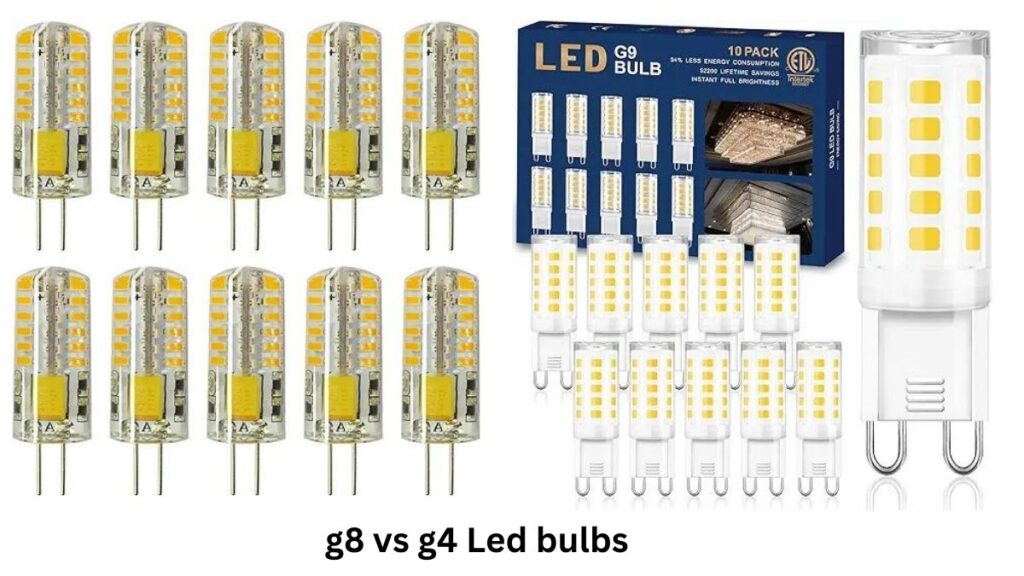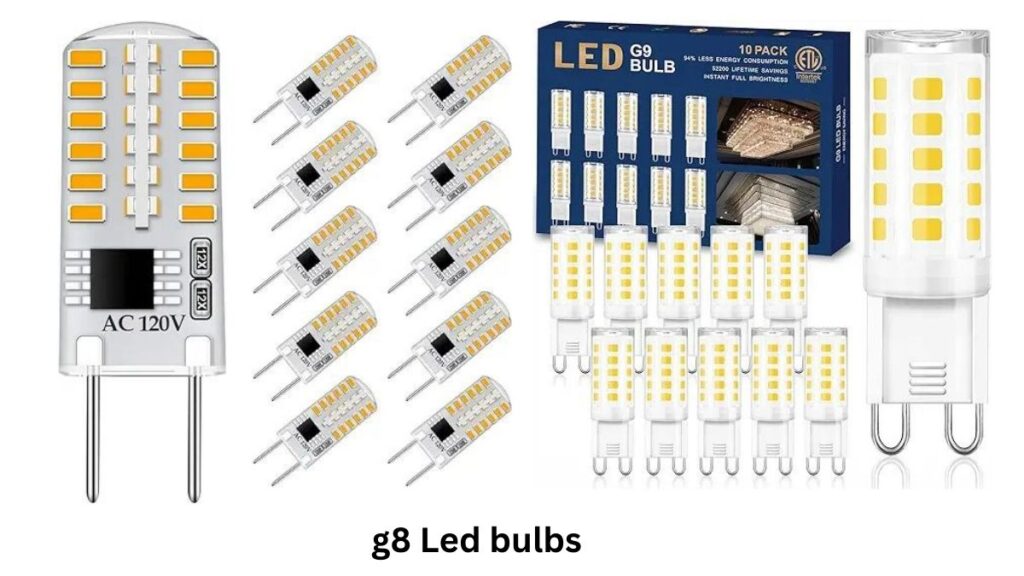When deciding on the best lighting for your space, the choice between G8 vs T4 bulbs can feel overwhelming. Each option comes with its own set of features, benefits, and drawbacks, making it essential to choose the one that fits your specific needs. In this guide, we’ll explore both G8 and T4 bulbs, diving into their uses, performance, energy efficiency, and much more. By the end, you’ll have all the information needed to make an informed decision that brightens your home while keeping your energy bills low.
Understanding G8 Bulbs
a). Definition and Basic Characteristics of G8 Bulbs
The G8 bulb is a type of bi-pin light bulb, named for the 8mm distance between its two pins. These bulbs are often compact, making them a popular choice for small fixtures like under-cabinet lighting and accent lamps. G8 bulbs come in various wattage options, including halogen and LED alternatives, allowing flexibility based on your energy needs.
b). Common Applications and Uses
G8 bulbs are commonly used in residential and commercial settings, especially where space is limited. You’ll frequently find them in kitchen under-cabinet lighting, desk lamps, or decorative fixtures. Their small size and directional light make them ideal for focused lighting applications like task lighting.
c). Advantages of G8 Bulbs
- Compact Size: Perfect for tight spaces.
- Energy-Efficient Options: LED G8 bulbs can significantly reduce your electricity usage.
- Bright, Focused Light: Ideal for accent lighting and areas where bright, direct light is needed.
- Long Lifespan (LED versions): LED alternatives to G8 bulbs offer longer-lasting performance compared to halogen options.
d). Potential Drawbacks or Limitations
- Heat Emission (Halogen): G8 halogen bulbs can generate heat, making them less energy-efficient.
- Limited Applications: Due to their size, they are not ideal for large rooms or general lighting purposes.
- Higher Upfront Cost (LED): While LED G8 bulbs save energy in the long term, they can be more expensive initially
Exploring T4 Bulbs
1. What Are T4 Bulbs and Their Key Features?
T4 bulbs, often referred to as T4 fluorescent tubes, are slender, long bulbs typically used in lighting fixtures that require linear light. The “T” in T4 stands for “tubular,” and the number 4 represents the diameter in eighths of an inch, making T4 bulbs 4/8 inches (or half an inch) thick. They come in fluorescent and LED versions, offering versatility in lighting design.
2. Typical Uses and Environments for T4 Bulbs
T4 bulbs are commonly found in under-cabinet lighting, display cases, and offices. They’re especially useful in situations where bright, even lighting is needed over a broad area. T4 bulbs are also popular in kitchens, closets, and workspaces.
3. Benefits of Choosing T4 Bulbs
- Energy Efficiency (Fluorescent and LED): T4 bulbs consume less power than many other lighting options, especially in their LED versions.
- Bright, Even Lighting: Ideal for large spaces that need uniform light distribution.
- Space-Saving Design: Their slim profile allows for discreet installation in compact areas.
- Cost-Effective: Fluorescent T4 bulbs offer a budget-friendly lighting solution with decent energy savings.
4. Possible Disadvantages to Consider
- Mercury Content (Fluorescent): T4 fluorescent tubes contain mercury, requiring special disposal.
- Shorter Lifespan (Fluorescent): Compared to LEDs, T4 fluorescent bulbs need more frequent replacements.
- Dimming Limitations: Not all T4 fluorescent bulbs are dimmable, limiting their flexibility in some settings.

G8 vs T4: A Head-to-Head Comparison
1. Size and Shape Differences
G8 bulbs are small and compact, usually designed for targeted lighting needs, while T4 bulbs are thin and long, better suited for large areas or even lighting. If space is a concern, G8 bulbs are the go-to, while T4 bulbs work better in larger fixtures.
2. Energy Efficiency and Power Consumption
Both G8 vs T4 bulbs come in energy-efficient LED versions, but traditionally, T4 fluorescent tubes consume less power than halogen G8 bulbs. LED G8 bulbs, however, close the gap, offering similar energy savings. When it comes to lumens output per watt, T4 bulbs may have the upper hand for large areas.
3. Light Output and Quality Comparison
G8 bulbs produce bright, focused light, ideal for accent lighting and task lighting. T4 bulbs, on the other hand, produce a more widespread, even light, perfect for general lighting in rooms or cabinets. The color rendering index (CRI) and color temperature options also vary, with both bulbs offering warm white and cool white lighting options.
4. Lifespan and Durability
LED versions of both G8 and T4 bulbs can last up to 25,000 hours, significantly outlasting their halogen and fluorescent counterparts. However, fluorescent T4 bulbs typically last between 7,000 to 15,000 hours, which is shorter than LED alternatives but still decent for their price.
5. Cost Considerations (Initial and Long-Term)
G8 bulbs, especially LED versions, tend to have a higher upfront cost than T4 fluorescent tubes. However, the energy savings and longer lifespan of LED G8 bulbs can make them more cost-effective over time. T4 fluorescent bulbs are cheaper initially but may require more frequent replacements, increasing long-term costs.
Installation and Compatibility
i). Fixture Requirements for G8 Bulbs
G8 bulbs typically require specific fixtures with bi-pin sockets. These are commonly found in under-cabinet and desk lamp lighting, and they are not as widely available as standard screw-in sockets.
ii). T4 Bulb Installation Considerations
T4 bulbs usually require a ballast, especially in fluorescent versions, which may complicate installation. However, LED T4 bulbs often come with retrofit options, making it easier to install them in existing fixtures.
iii). Interchangeability and Adapter Options
While G8 and T4 bulbs are not directly interchangeable due to their different shapes and sizes, some adapters and retrofit kits may allow you to convert fixtures to LED versions of either bulb.
iv). Safety Precautions for Each Bulb Type
When installing halogen G8 bulbs, be mindful of the heat they generate. For T4 fluorescent tubes, proper disposal is necessary due to the mercury content. LED versions of both bulbs are safer and more environmentally friendly, with no heat or hazardous materials.
Environmental Impact and Energy Savings
1. Energy Efficiency Ratings for G8 and T4 Bulbs
Both G8 and T4 bulbs, especially in their LED forms, are highly energy-efficient. LED alternatives to G8 and T4 bulbs are often Energy Star certified, ensuring optimal performance with minimal power consumption.
2. Carbon Footprint Comparison
T4 fluorescent bulbs have a higher carbon footprint due to their mercury content and shorter lifespan. LED G8 and T4 bulbs, on the other hand, are more eco-friendly, using less energy and lasting longer, thus reducing waste.
3. Disposal and Recycling Considerations
Fluorescent T4 bulbs must be disposed of carefully due to their mercury content. LEDs, whether G8 or T4, are safer and can often be recycled, contributing to a lower environmental impact.
4. Long-Term Environmental Benefits of Each Option
LED G8 and T4 bulbs are the clear winners when it comes to long-term environmental benefits. Their low energy usage, long lifespan, and lack of hazardous materials make them an eco-friendly choice.
Making the Right Choice for Your Needs
1. Factors to Consider When Choosing Between G8 and T4
If you’re lighting a small space or need targeted light, G8 bulbs are a perfect fit. For larger areas or even lighting, T4 bulbs might be the better choice, especially in their fluorescent or LED forms.
2. Room-Specific Recommendations
- G8 Bulbs: Ideal for kitchens, under-cabinet lighting, or accent lighting in living rooms and bedrooms.
- T4 Bulbs: Perfect for office lighting, workspaces, and larger kitchens.
3. Professional vs DIY Installation Considerations
Both G8 and T4 bulbs are relatively easy to install. However, fluorescent T4 bulbs may require professional help due to the ballast and wiring. LED versions of both bulbs are more DIY-friendly.
4. Future Trends in Lighting Technology
With smart lighting integration becoming more popular, both G8 and T4 bulbs will likely see more LED and smart lighting options in the future. This allows for greater control, energy savings, and convenience.
Conclusion
Illuminating your space is more than just flipping a switch – it’s about making an informed decision that balances aesthetics, efficiency, and functionality. Whether you’re team G8 or leaning towards T4, remember that the best bulb is the one that fits your unique needs and space. As lighting technology continues to evolve, staying informed about options like G8 vs T4 bulbs empowers you to create the perfect ambiance while being kind to both your wallet and the planet. Ready to light up your life? The choice is in your hands!
Related articles:
Hi, I’m Malik Suhail—an SEO expert, web designer, and passionate blogger with 2 years of experience. I specialize in crafting content that is not only informative but also tailored to meet the needs of my readers.
I write about diverse topics, always striving to simplify complex ideas and provide valuable insights that resonate with my audience. Whether it’s about SEO strategies, web design trends, or blogging tips, I am committed to delivering well-researched, practical, and easy-to-understand information.
My mission is to help readers navigate the digital world with confidence and clarity. I believe in adding value through authentic content that inspires action and delivers results.


